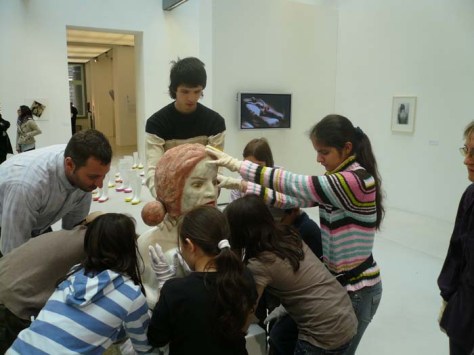Why touching art is so tempting — and exciting. Repost from CNN.
Updated 13th May 2019
Marlen Komar, CNN
Imagine an empty gallery in a museum. It’s just you, a 200-year-old masterpiece and the quiet. The brush strokes of a Rembrandt painting draw you in, and with your hands behind your back, you lean in to study the colors and textures.
Looking sideways, you spot the security guard at the door, standing bored and inattentive. You could easily reach out your hand and steal a quick touch, rules be damned.
Fiona Candlin, a professor of museology at Birkbeck College in London and author of “Art, Museums, and Touch,” is all too familiar with these clandestine moments. She spent years investigating the motivations behind why visitors touch exhibits without permission, what they choose to touch, and how these unauthorized touches make them feel.
As it turns out, this type of rule-breaking is a common part of the museum-going experience. While she was observing unauthorized touching at the British Museum for a report published in The Senses and Society journal, a security guard told Candlin, “You stop a hundred people touching and there are 200 more … It’s like trying to turn back the sea.”
Closer inspection
Museums are often seen as sober places, where visitors are expected to silently walk from gallery to gallery and contemplate art from a distance. But Simon Hayhoe, a lecturer at the University of Bath who specializes in art education and disability, suggests we often want to close that distance and interact with works more intimately.
Solid gold toilet to land in English stately home
He links this to the original purpose of Renaissance artworks, which were hung inside churches to teach people about Bible stories. The pieces were hung in a way that created a sense of remoteness and reverence, and made the viewer feel like an outsider.
“What the church did was put the art out of reach. They never put it close to the people so they can stand in front of it. They were designed to be seen (up) high, and so people would look at them in awe and wonder,” Hayhoe explained in a phone interview.

“So there is a sense of power there as well. There is a sense of you are not allowed anywhere near this painting, because it’s imbued with God, it’s imbued with power, it’s imbued with something you’re never going to be close to.”
According to Candlin, there are numerous reasons why museum visitors are so tempted to touch art, one of which is classic empirical investigation — simply put, the desire to learn more.
“If you want to find out how finely a surface has been finished, or how two bits are joined together, or how deep an engraving is, the best way to find out is by touching it,” Candlin said in a phone interview.
“You want to know how something is made, you want to know what it’s made of, you want to try and get a sense of how it’s put together, and so you touch for those kinds of reasons.”
Part of that inspection is to confirm authenticity. “There can be a real blur between museums and experiences and theme parks and wax works. Often if you have really big objects on display — if you think about going into the Egyptian galleries in the British Museum or the Met. Some people can’t believe you would put real things on display without glass around them. They’re not quite sure and they figure if they touch it, they can make an assessment,” Candlin said.

Touching also has to do with playing with the art pieces on display — especially when it comes to statues of animals and humans. But because these figures aren’t real, museum-goers feel free to push boundaries, patting lion heads or groping naked bottoms. They’re making visual jokes and performing for both themselves and the people they are with.
In Candlin’s research, she found that the British Museum’s Lely Venus, a Roman statue of the goddess leaving her bath, had her behind cupped so often that the piece was put behind barriers.
An emotional connection
Standing in front of artwork also often evokes an emotional response. It’s not just about appreciating technique, Candlin explained, but thinking of the human element behind the work and wanting to connect with the person behind the genius.
“If something is made by a named artist, the museum goer wants to feel they have some connection with that named artist. Barbara Hepworth put her hand here and I’m now putting my hand here,” Candlin said.
“There is a sculpture by Hepworth at the Yorkshire Sculpture Park (in England) where you can see her finger marks in it, and if people notice it they will often put their hand against her finger marks to give that sense of her hand and their hand meeting.”
While she doesn’t go so far as to suggest people break the rules the next time they’re at a museum, Candlin does believe touching is an important — and, unfortunately for security guards, inevitable — part of experiencing art.
“People aren’t just touching the ends of their fingers — they’re stroking things, they’re holding things, they’re mimicking,” she continued. “You’ve got to see touching as part of the continuum of ways in which people physically interact with objects.”
























